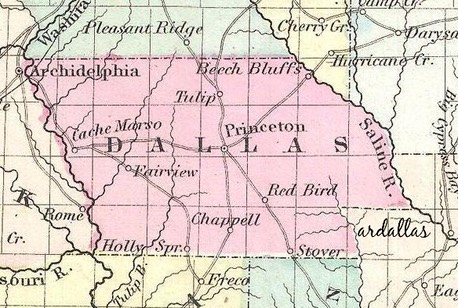Holly Springs was created between 1850 and 1856 from parts of Tulip Township.
Holly Springs, a Dallas County community is located 15 miles southeast of Princeton on Highways 9 and 128, was originally settled in 1841. Holly Springs received its name from the Holly groves and beautiful springs in the area. Some of the early settler's names were Launius, House, Key, Crownover, Galling, Head, Proctor, Stells, Peterson, Chambers, Sorrell, Beard and Henry. Holly Springs Township was formed in 1850. At the time there were two general merchandise stores. One was the Henry and Proctor store and the other was the W. B. Head store, who was also Justice of the Peace. Richard C. Key was the first postmaster in 1850. Cap. John A. Goodgame, merchant and farmer, came to Holly Springs in 1851. Holly Springs had some steam powered gristmills and two cotton gins Joe Key built the first gristmill in Holly Springs and also had a tannery. During the war, he made shoes for the soldiers.
In Holly Springs, the St. John's lodge was organized in 1850 with charter members R. C. Key, A. A. Key, and D. C. Campbell. The lodge met every Saturday night before the full moon.
The schools of Holly Springs were at first private, then subscription schools. The school met in a log cabin. The Judson Baptist Association sponsored a High School at Holly Springs that was called the Judson Baptist Academy. It was a tuition school for boys and girls. W. R. McEwen was the professor. McEwen also published The Star Weekly, a four page four-column paper with Dr. O. O. Wozencraft as one of the stock holders. The Judson Baptist Academy operated until 1901 when the building burned. In 1902, the Judson Baptist Association deeded the land to the Holly Springs School District. After the new Holly Springs School building (two story) was erected the Masonic Lodge leased the upstairs for their meetings for the sum of $1 (lease was good as long as the lodge maintained a charter). The Holly Springs school trustees in 1903 were O. O. Wozencraft, W. H Henry, G. L. Sorrells, E. E. Pryor and J. W. Jones.
Politics and the medical profession were strong in Holly Springs. W. L. Patterson was elected to the House of Representatives in 1885 and served until 1889 when he was elected Senator. The doctors in Holly Springs were Moses J. Mitchell, O. O. Wozencraft and Folden. Dr John K. Hodge was born in Holly Springs in 1950. After about six years in practice at Holly Springs with his father, Hodge moved to Princeton. W. L. Wozencraft joined his father in practice at Holly Springs.
In Holly Spring religion has a long history. The Methodist congregation existed in 1827. In 1848, the Methodist preacher T. Q. C. House, a teacher, landowner and business man, began his ministry. The Baptist church was organized in 1833 with Rev. P. J. Crowder as pastor. Holly Springs had an influential Negro preacher, the Rev. Richard Anderson Sinquefield (born near Indian Springs in Butt County, Georgia, in 1832 and died 1908).
Source: Merritt, Richard (1976) Review of Dallas County, AR History gleaned from the Bicentennial Edition of the FORDYCE-NEWS ADVOCATE.
If you have any additional information or photos of this place, please contact me and I will place them online.

Holly Springs on a 1855 map of Arkansas.
